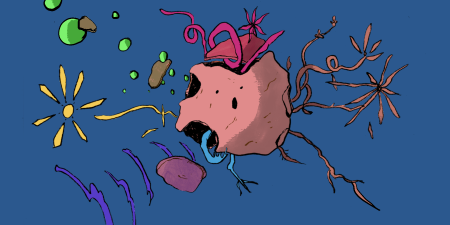Abstract
Palliative interventions are intended to alleviate suffering and improve quality, not quantity, of life and are not intended to cure illness. In psychiatry, uncertainty about which interventions count as palliative stems from the fact that psychiatry generally prioritizes symptom management irrespective of diagnosis or specific pathophysiology of illness. This commentary on a case considers how distinctions between palliative and other psychiatric interventions might not be all that helpful in resolving clinical and ethical questions about which interventions are—and when they are—appropriate.
Case
CC is a 40-year-old patient who has experienced multiple shifts in diagnoses over 10 years among mood disorders, substance use disorders, and personality disorders. CC is currently recovering from a 6-year addiction to cocaine and has been involuntarily admitted several times during the last 8 years for self-harm. After just over 1 year of reliable symptom control with an antidepressant, electroconvulsive therapy, and psychotherapy, CC is again experiencing passive suicidal ideation and worsening depression. Dr P worries that CC might attempt suicide or relapse into drug use and wonders whether a new US Food and Drug Administration (FDA)-approved drug for depression and suicidal ideation would help. This drug rapidly reduces suicidal ideation in a matter of hours in some cases, but evidence does not yet reliably indicate how long suicidal ideation is reduced after treatment or whether suicidal ideation reduction is attributable to dissociation and euphoria, for which the drug has become known since it started being used recreationally.
Commentary
Cases like this one frequently confront psychiatrists and other mental health professionals. They raise important questions about how these practitioners should address severely treatment-refractory symptoms. The case also raises a difficult question about whether an intervention that carries a risk of addiction—since the proposed intervention produces euphoria, which is associated with dependence1—should be used in order to achieve other benefits, such as the reduction of suicidal ideation. As we see it, the central dilemma of the case is this: Should Dr P give CC the new FDA-approved treatment, given the possibility that it will reduce her suicidal ideation, despite the risk that she could become addicted to it?
It is tempting to suppose that this question can be answered by applying the concept of palliative psychiatry. Would giving the new medication to CC be a palliative intervention? And, if so, is CC the sort of patient for whom palliative interventions would be appropriate? There is some merit to this approach to reframing our thinking, but we do well to remember that asking whether palliative interventions are appropriate for patients endorses a false dichotomy. After briefly reviewing attempts to define palliative psychiatry, we argue that distinguishing features of palliative psychiatry remain unclear. Irrespective of whether a new medication should be considered palliative for CC, what Dr P should do depends mainly on whether the medication promotes CC’s best interest and whether it offers greater expected net benefit than alternative interventions. In other words, whether it is properly called palliative requires investigation.
Defining Palliative Psychiatry
According to the World Health Organization (WHO), palliative interventions are focused on alleviating suffering and improving quality of life.2 In theory, a palliative approach could be taken to any kind of illness, including mental illness.
The concept of palliative psychiatry was originally described by Berk and colleagues in 2012.3 They noted that persons with severe mental illness often receive aggressive treatment, show little response to treatment, and have high levels of disability; they suggested that adopting a palliative approach could benefit such persons by reducing rehospitalization and side effects of medications. Levitt and Buchman subsequently suggested that palliative interventions should be considered whenever other treatments for a psychiatric illness seem “futile,”4 meaning (in this context) that they are unlikely to produce significant changes in symptoms and that the patient will still likely see her quality of life as unacceptable. Separately, Trachsel and colleagues suggested that palliative interventions are a way to avoid futile care.5 They offered a definition of futility similar to Levitt and Buchman’s and implied that palliative psychiatry should be construed as involving unconventional treatments, such as psychiatric “long-term residential care for patients with clozapine-resistant schizophrenia,” avoidance of involuntary refeeding for severe enduring anorexia nervosa, and palliative sedation for treatment-refractory depression coupled with a life-threatening somatic illness.
More recently, Westermair and colleagues defined palliative psychiatry in the narrow sense as the “provision of end-of-life care for persons dying from a mental illness” and palliative psychiatry in the broad sense as involving “all approaches aiming at improving quality of life by means other than reduction of … symptoms, namely harm reduction and relief of suffering.”6 They give as examples of broad palliative care supervised injectable heroin for treatment-refractory opioid use disorder and the Community Outreach Partnership Program for anorexia nervosa, which involves “letting go of curative goals of care … that are in all likelihood unattainable” and instead focusing on “relief of suffering and improvement of quality of life.”
When Is a Psychiatric Treatment Palliative?
Despite these attempts to define palliative psychiatry, it is uncertain whether the new medication that Dr P is considering for CC counts as palliative in any interesting sense. According to the WHO definition of palliative care, for it to do so, it would have to focus not on curing the underlying illness but primarily on reducing suffering or improving quality of life. We would also add a third consideration: for the distinction between palliative and non-palliative psychiatric interventions to be ethically relevant, it must be the case that most ordinary psychiatric treatments do not already count as palliative according to the WHO definition. The problem is that ordinary psychiatric care looks palliative in that sense.
If there is no set of psychiatric interventions that are uniquely palliative, then palliative psychiatry is just the same as ordinary psychiatry.
Consider the first condition—whether a treatment is focused on curing an illness. Many psychiatric treatments are not curative in the sense that they do not eliminate or normalize some underlying disease process. Psychiatric illnesses often have high relapse rates despite treatment, and many require lifelong treatment to reduce the risk of relapse.7,8,9,10 Based on these facts, it can be inferred that many psychiatric treatments are not focused on a cure in the sense of eliminating or normalizing a disease process. One might think, however, that “curative” interventions need not eliminate a disease process but only target its pathophysiology. Nevertheless, many ordinary psychiatric treatments do not seem to address disease processes even in this weaker sense. Indeed, many psychiatric treatments have mechanisms that are still incompletely characterized and are plied against conditions with poorly defined causes.11,12,13,14 Do ordinary antidepressants like fluoxetine really “cure” major depressive disorder (MDD), in the sense of correcting some biological difference that is causative of (or at least contributory to) that condition, or do they simply cause changes in brain states that make the symptoms of MDD less bad? Surprisingly, the answer to this question is not known.15 Other treatments, such as benzodiazepines administered for generalized anxiety disorder, might also be regarded as simply alleviating a symptom without specifically “curing” any illness, since benzodiazepines reduce anxiety whether or not one has generalized anxiety disorder.16
Related to the second condition—whether a treatment is focused on reducing suffering or improving quality of life—mental illnesses are typically defined in terms of symptoms, as evidenced by diagnostic criteria laid out in the fifth edition of the Diagnostic and Statistical Manual of Mental Disorders.17 Thus, to “treat” a mental illness successfully is necessarily to alleviate the symptoms defining it, much like “treating” pain often means alleviating the pain with an analgesic without addressing the cause of the pain. It follows that most psychiatric treatments are aimed at improving symptoms—thereby reducing suffering and improving quality of life—and can plausibly be classified as palliative based on the WHO definition.
But if there is no set of psychiatric interventions that are uniquely palliative, then palliative psychiatry is just the same as ordinary psychiatry. This is probably why Westermair and colleagues define palliative psychiatry in the broad sense as involving “all approaches aiming at improving quality of life by means other than reduction of … symptoms” (emphases added).”6 But this definition, although intended to capture palliative psychiatry broadly, is still too narrow, since relief of difficult symptoms is often an essential part of relieving suffering and improving quality of life. The inseparability of symptom relief and palliative care goals is also true of general palliative care, wherein palliative treatment for metastatic prostate cancer, for example, should involve alleviating the pain that is a symptom of the cancer.18 Likewise, using sedation to alleviate the anxiety of a person with severe treatment-refractory panic disorder19 would seem to be palliative, even though treatment is focused on improving a troublesome symptom.
Does It Matter Whether a Treatment Is Palliative?
Although it remains deeply unclear how to distinguish specifically palliative psychiatric interventions from ordinary psychiatric interventions, this distinction is neither clinically nor ethically necessary. Lindblad and colleagues have argued that a definition of palliative psychiatry adds little to conventional conceptions of palliative care and is not necessary for goals-of-care discussions for patients with severe persistent psychiatric illness.20 Critical treatment decisions like CC’s should, as with any treatment decision, be determined primarily by a comparison of the risks and benefits of the treatment with its alternatives. Thus, we argue, whether or not the new treatment is palliative, it should be offered to CC only if the expected net benefit (defined as the expected benefit minus the expected harm) of this new intervention is better than any alternatives. Conversely, if the new treatment’s expected net benefit is less than some alternative, then CC should not be offered it, whether or not it is palliative.
We noted earlier that it has been argued that whether a patient’s symptoms are extremely treatment refractory—so that ordinary treatments start to seem “futile”—might determine whether a palliative approach is necessary.4,5 But, on our view, the degree to which a patient’s symptoms are treatment refractory matters only because it is a guide to whether the risk-benefit ratio of unconventional treatments (eg, opioids to treat mood or anxiety, continuous sedation to treat refractory distress, or even withdrawing guideline-approved interventions such as clozapine in treatment-refractory schizophrenia) is likely to be favorable compared to alternatives. If someone’s condition is very treatment refractory, the relative expected net benefit of a novel treatment might be great enough that it is worth trying, even if the risks are great.
We concede that use of the term palliative psychiatry to denote more (or less) intensive, unconventional treatments for patients with extremely treatment-refractory conditions could have a sort of hermeneutic benefit even if it is not conceptually justified. It could help psychiatrists, patients, family members, insurers, hospital administrators, and others recognize a set of clinical possibilities that are otherwise hidden. It could help psychiatrists who are caring for such patients redirect their attention from treating illness as the primary method for improving those patients’ lives to simply trying to improve patients’ lives per se. Publicly distinguishing between palliative and non-palliative approaches in psychiatry might make it easier to countenance potentially helpful interventions that usually seem inappropriate because, for instance, they are not even ostensibly aimed at treating an illness or they aim at improving quality of life even at the cost of some unwanted side effect, such as addiction.
Conclusion
Ultimately, then, what matters when it comes to recommending an intervention is whether, for the patient, the expected net benefits of that intervention are greater than the expected net benefits of other interventions. Perhaps all psychiatric interventions are palliative. Perhaps none of them are. But whether we should offer a particular treatment, provided other moral constraints are satisfied, depends primarily on whether it stands to benefit the patient most, on balance, relative to the other things we could do to help the patient. The main value in the concept of palliative psychiatry is in helping us see that.
References
- Swainson J, Klassen LJ, Brennan S, et al. Non-parenteral ketamine for depression: a practical discussion on addiction potential and recommendations for judicious prescribing. CNS Drugs. 2022;36(3):239-251.
-
Palliative care. World Health Organization. August 5, 2020. Accessed August 4, 2022. https://www.who.int/news-room/fact-sheets/detail/palliative-care
- Berk M, Berk L, Udina M, et al. Palliative models of care for later stages of mental disorder: maximizing recovery, maintaining hope, and building morale. Aust N Z J Psychiatry. 2012;46(2):92-99.
-
Levitt S, Buchman DZ. Applying futility in psychiatry: a concept whose time has come. J Med Ethics. 2020;47(12):e60.
-
Trachsel M, Irwin SA, Biller-Andorno N, Hoff P, Riese F. Palliative psychiatry for severe and persistent mental illness. Lancet Psychiatry. 2016;3(3):200.
- Westermair AL, Buchman DZ, Levitt S, Perrar KM, Trachsel M. Palliative psychiatry in a narrow and in a broad sense: a concept clarification. Aust N Z J Psychiatry. 2022;56(12):1535-1541.
-
Touya M, Lawrence DF, Kangethe A, Chrones L, Evangelatos T, Polson M. Incremental burden of relapse in patients with major depressive disorder: a real-world, retrospective cohort study using claims data. BMC Psychiatry. 2022;22:152.
- Kessing LV, Hansen MG, Andersen PK, Angst J. The predictive effect of episodes on the risk of recurrence in depressive and bipolar disorders—a life-long perspective. Acta Psychiatr Scand. 2004;109(5):339-344.
-
Emsley R, Chiliza B, Asmal L, Harvey BH. The nature of relapse in schizophrenia. BMC Psychiatry. 2013;13:50.
- Eisen JL, Goodman WK, Keller MB, et al. Patterns of remission and relapse in obsessive-compulsive disorder: a 2-year prospective study. J Clin Psychiatry. 1999;60(5):346-351.
-
Moncrieff J, Cohen D. Do antidepressants cure or create abnormal brain states? PLoS Med. 2006;3(7):e240.
-
Moncrieff J, Cooper RE, Stockmann T, Amendola S, Hengartner MP, Horowitz MA. The serotonin theory of depression: a systematic umbrella review of the evidence. Mol Psychiatry. Published online July 20, 2022.
- Magioncalda P, Martino M. A unified model of the pathophysiology of bipolar disorder. Mol Psychiatry. 2022;27(1):202-211.
- Grace AA. Dysregulation of the dopamine system in the pathophysiology of schizophrenia and depression. Nat Rev Neurosci. 2016;17(8):524-532.
- Albert PR, Benkelfat C, Descarries L. The neurobiology of depression—revisiting the serotonin hypothesis. I. Cellular and molecular mechanisms. Philos Trans R Soc Lond B Biol Sci. 2012;367(1601):2378-2381.
- Murphy SE, Downham C, Cowen PJ, Harmer CJ. Direct effects of diazepam on emotional processing in healthy volunteers. Psychopharmacology (Berl). 2008;199(4):503-513.
-
American Psychiatric Association. Diagnostic and Statistical Manual of Mental Disorders (DSM-5). 5th ed. American Psychiatric Publishing; 2013.
- Thompson JC, Wood J, Feuer D. Prostate cancer: palliative care and pain relief. Br Med Bull. 2007;83(1):341-354.
- Schuman-Olivier Z, Brendel DH, Forstein M, Price BH. The use of palliative sedation for existential distress: a psychiatric perspective. Harv Rev Psychiatry. 2008;16(6):339-351.
-
Lindblad A, Helgesson G, Sjöstrand M. Towards a palliative care approach in psychiatry: do we need a new definition? J Med Ethics. 2019;45(1):26-30.



